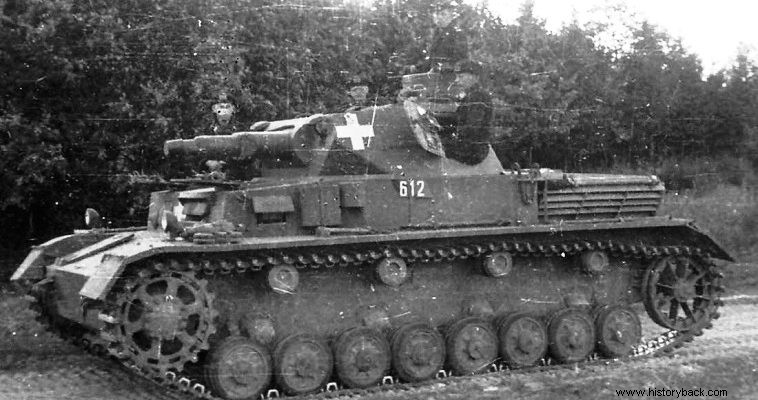
On September 1, 1939, the German Army breached the Polish border. World War II was already a fact. Against Poland and its western allies (Britain, France), the German Army had neither numerical nor qualitative superiority, despite the opinions to the contrary circulating. The Germans were superior only in tactics and in air power. In every case they took advantage of the weaknesses and poor coordination of their enemies' actions and thanks to their superiority, they attacked and defeated one after the other the opposing armies.
When Hitler was massing his forces against Poland, he risked the maximum by leaving only 44 (20 reserve) infantry divisions to guard his western border against the bulk of the French Army, totaling approximately 100 divisions of each type. The Polish Army in turn had 30 infantry divisions, 9 reserve infantry divisions, 11 cavalry brigades and 3 mountain infantry brigades. At least 4 British divisions that were then in France should be added to these forces.
Against these forces, the German Army had about 110 divisions of each type, of which 6 armored, 4 light and 6 motorized. At that time the Germans had no more than 2,500 tanks, the vast majority light. At the same time the French Army had almost 3,500 tanks (also light most). If, while the German soldiers were crossing the Polish border, the French generals had carried out a bold attack with the units of the active Army alone (almost 40 divisions), the outcome of the war would have been different. But the Allies acted completely uncoordinated and succumbed one after the other. It is a fact that the Polish generals themselves committed tragic strategic mistakes in choosing their defensive location while fatally underestimating the enemy.
Without a strong Air Force, without many and powerful tanks, the Polish Army was in no way supposed to fight the impending defensive battle, overextended along the 2,800 km stretch of its homeland's border with Germany. Having no idea of what awaited them, the Polish generals looked with optimism to the future. Surprised from the first moment by the speed and ferocity of the enemy attack, the Polish Army did not even manage to mobilize as a whole. On September 1, 1939, only 17 divisions and 4 brigades of his infantry and cavalry were ready. Even these forces, however, horribly inadequate anyway, fought the battle scattered at the four points of the horizon.
For the attack on Poland, the German High Command of the Armed Forces threw two army groups into battle. The southern and stronger Army Group A was deployed, under the command of General von Rudstedt, on the German-Polish border in the region of Silesia. Army Group II, under von Bock, was deployed in two areas, East Prussia and Pomerania. The entire operation was supported from the air by the 1st and 4th Air Fleets (Luftflote). Army Group A' included three armies, the 14th (Liszt), the 10th (von Reichenau) and the 8th (Blaskowicz).
The 10th Army had 15 divisions, including four armored, three light and two motorized. This army was the strategic battering ram, destined to crush the Polish center (Lodz and Kraków Armies) in cooperation with the 8th Army. The 14th Army was tasked with sweeping Polish resistance along the Carpathian fringes. Army Group A held five infantry divisions in reserve. Later it was also allocated von Kleist's 22nd Panzer Army Corps and two mountain infantry divisions.
Army Group B, although less powerful, was arranged in such a way that its forces were able to outflank the Polish. In Pomerania, von Kluge's 4th Army, spearheaded by Guderian's 19th Panzer Corps, was tasked with breaking up the Polish front in the area of the Danzig Corridor and linking it up with Kichler's East Prussian 3rd Army. With the support of the Air Force, the German Army went on the offensive, putting into practice for the first time its new tactics of Blitzkrieg (Blietzkrieg). The overextended Polish forces were soon broken, despite the unfathomable heroism they displayed.
The Polish Army of Pomerania (General Brodowski) was irreparably broken and the Army of Poznań (General Kurzeba) was surrounded. To the south, the Army of Kraków was also crushed and the Army of Łódź was encircled. Just seven days after the start of the campaign, the battle was already won by the Germans. The Polish forces continued to fight heroically, trapped in a series of pockets, with no chance of success.
The Polish cavalry and infantry could not retreat with a speed commensurate with the advancing German motorized phalanxes. In whatever direction the Poles marched, they met their opponents everywhere. Bombed by the Luftwaffe and strangled by the German Army, the Poles on September 17 received the gratuitous shot of the cowardly Soviet offensive. It was the end.
Although fighting continued until October 1939 and armed resistance did not stop until the winter of 1940, the battle for the Germans had been won. It was the first blitzkrieg campaign of the war, which ended in complete victory for the side that possessed air superiority, tactical superiority, and agility. The Polish campaign cost the German Army 10,572 dead, 3,409 missing and 30,332 wounded. These were losses equivalent to the personnel of 2 1/2 divisions. On the contrary, the Poles had 60,000 dead, 180,000 wounded and almost 800,000 prisoners.
